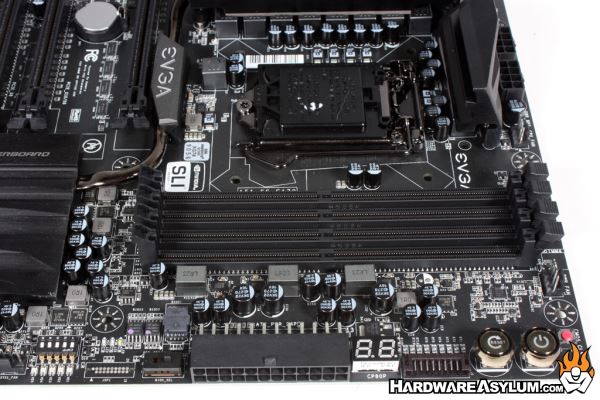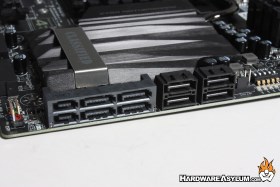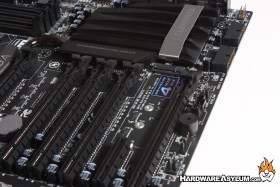EVGA Z170 Classified Motherboard Review
Author: Dennis GarciaBoard Layout and Features Continued
Dual channel memory comes standard on the Skylake processor and the Z170 Classified supports standard speed DDR4 modules up to 2133Mhz with overclocking support beyond 3600Mhz. A maximum of 64GB is addressable with the proper module density.

Benchtop controls are located in the upper left of the motherboard below the memory slots and near the 24 pin power connector. These consist of power, reset and CMOS clear. Nearby you'll find a dual purpose debug LED that reads off post codes during boot and later relays CPU temp.
Voltage test points are no longer a series of pads on the PCB but instead can be found as a pin block located near the power and reset switches. The test leads that connect here are voltage meter friendly and follow a standard format found on custom EVGA video cards.
Above the SATA connections you will find a series of DIP switches which allow you to disable any of the PCI Express slots. This gives you a convenient way to run multi card benchmarks without having to tear everything down and also helps you debug when something goes wrong. Next to these you’ll find the BIOS selection switch for enabling one of the three onboard BIOS chips.
You may also notice that one of the chips is removable allowing you a bootable option in case of a triple BIOS failure or when you need access to more than three images.
Internal SATA connections number six and follow the new SATA6 connection standard. Two of the standard SATA6 ports are dedicated to SATA Express from the chipset. There are two additional SATA ports to the right that are controlled by an onboard ASMedia controller which also provides USB 3.1.
The Z170 chipset comes with 20 PCI Express 3.0 lanes which happen to be more than you get with the Skylake processor. Unlike the CPU bandwidth the chipset PCIe is intended for connectivity and storage. You will find a total of two M.2 slots on the motherboard with an interesting formula to determine bandwidth and what is disabled during use. Key-M (pictured) shares bandwidth with the onboard SATA while Key-E, along the left, is shorter but also pure PCI Express.



